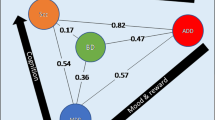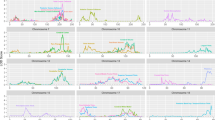Abstract
The most characteristic features of bipolar affective disorder (manic-depressive illness) are episodes of mania (bipolar I, BPI) or hypomania (bipolar II, BPII) interspersed with periods of depression. Manic-depressive illness afflicts about one percent of the population, and if untreated, is associated with an approximately 20% risk of suicide1. Twin, family and adoption studies provide compelling evidence for a partial genetic aetiology, but the mode(s) of inheritance has not been identified2. Nonetheless, the majority of genetic linkage studies have assumed classical mendelian inheritance attributable to a single major gene. Although segregation analyses have yielded inconsistent results (with most studies rejecting a single locus inheritance model), the best single gene model is dominant inheritance if only BPI is considered3. Reported linkages of bipolar affective disorder on chromosomes 11, 18, 21 and X have been difficult to substantiate, and additional studies are required for replication or exclusion of these regions4–9. We now present the results of our genome-wide linkage analyses that provide evidence that regions on chromosomes 6, 13 and 15 harbour susceptibility loci for bipolar affective disorder, suggesting that bipolar affective disorder in the Old Order Amish is inherited as a complex trait.
This is a preview of subscription content, access via your institution
Access options
Subscribe to this journal
Receive 12 print issues and online access
$209.00 per year
only $17.42 per issue
Buy this article
- Purchase on Springer Link
- Instant access to full article PDF
Prices may be subject to local taxes which are calculated during checkout
Similar content being viewed by others
References
Goodwin, F.K. & Jamison, K.R., Manic-Depressive Illness. (Oxford University Press, New York, 1990).
Craddock, N. & McGuffin, P. Approaches to the genetics of affective disorders. Ann.Med. 25, 317–322 (1993).
Pauls, D.L., Bailey, J.N., Carter, A.S., Alien, C.R. & Egeland, J.A. Complex segregation analyses of Old Order Amish families ascertained through bipolar I individuals. Am. J. Med. Genet. (Neuropsy. Genet.) 60, 290–297 (1995).
Egeland, J.A. et al. Bipolar affective disorder linked to DMA markers on chromosome 11. Nature 325, 783–787 (1987).
Kelsoe, J.R. et al. Re-evaluation of the linkage relationship between chromosome 11 p loci and the gene for bipolar affective disorder in the Old Order Amish. Nature 342, 238–243 (1989).
Berrettini, W.H. et al. Chromosome 18 DMA markers and manic-depressive illness: evidence for a susceptibility gene. Proc. Natl. Acad. Sd. USA 91, 5918–5921 (1994).
Straub, R.E. et al. A possible vulnerability locus for bipolar affective disorder on chromosome 21 q22.3. Nature Genet. 8, 291–296 (1994).
Pekkarinen, P. et al. Evidence of a predisposing locus to bipolar disorder on Xq24–q27.1 in an extended Finnish pedigree. Genome Res. 5, 105–115 (1995).
Pauls, D.L. et al. Linkage analyses of chromosome 18 markers do not identify a major susceptibility locus for bipolar affective disorder in the Old Order Amish. Am. J. Hum. Genet. 57, 636–643 (1995).
Lander, E. & Kruglyak, L. Genetic dissection of complex traits: guidelines for interpreting and reporting linkage results. Nature Genet. 11, 241–247 (1995).
Cockerham, C.C. Analyses of gene frequencies of mates. Genetics. 74, 701–712 (1973).
Kruglyak, L. & Lander, E.S. Complete multipoint sib pair analysis of qualitative and quantitative traits. Am. J. Hum. Genet. 57, 439–454 (1995).
Egeland, J.A. & Hostetter, A.M. Amish study I: affective disorders among the Amish, 1976–1980. Am. J. Psychiat. 140, 56–61 (1983).
Egeland, J.A. An epidemiologic and genetic study of affective disorders among the Old Order Amish. in Genetic Studies in Affective Disorders, (eds Papolos, D.F. & Lachman, H.M.) 70–90 (John Wiley & Sons, New York, 1994).
Hostetter, A.M., Egeland, J.A. & Endicott, J. Amish study II: consensus diagnoses and reliability results. Am. J. Psychiat. 140, 62–66 (1983).
Endicott, J. & Spitzer, R. A diagnostic interview: the schedule for affective disorders and schizophrenia. Arch. Gen. Psychiat. 35, 837–844 (1978).
Spitzer, R., Endicott, J. & Robins, E. Research diagnostic criteria: rationale and reliability. Arch. Gen. Psychiat. 35, 773–782 (1978).
Egeland, J.A. et al. The impact of diagnoses on genetic linkage study for bipolar affective disorders among the Amish. Psychiat. Genet. 1, 5–18 (1990).
Egeland, J.A. Amish major affective disorders pedigrees, in 1994–1995Catalog of Cell Lines, NIGMS Human Genetic Mutant Cell Repository. 408–428, 992–999 (NIH Publication 94–2011, 1994).
Neitzel, H.A. A routine method for the establishment of permanent growing lymphoblastoid cell lines. Hum. Genet. 73, 320–326 (1986).
Matise, T.C., Perlin, M. & Chakravarti, A. Automated construction of genetic linkage maps using an expert system (MultiMap): a human genome linkage map. Nature Genet. 6, 384–390 (1994).
Donis-Keller, H. et al. A genetic linkage map of the human genome. Cell 51, 319–337 (1987).
Gyapay, G. et al. The 1993–94 Généthon human genetic linkage map. Nature Genet. 7, 246–339 (1994).
Sambrook, J., Fritsch, E.F. & Maniatis, T., Molecular Cloning, A Laboratory Manual, 2nd edn (Cold Spring Harbor Press, New York, 1989).
Vignal, A. et al. Nonradioactive multiplex procedure for genotyping of microsatellite markers, in Methods in Molecular Genetics, (ed. Adolph, K.W.) 211–221 (Academic Press, Ortando, 1993).
Bailey-Wilson, J.E. & Elston, R.C. SAGE: statistical analyses for genetic epidemiology.Version 2.0. (Louisiana State University Medical Center, New Orleans, 1989).
Haseman, J.K. & Elston, R.C. The investigation of linkage between a quantitative trait and a marker locus. Behav. Genet. 2, 3–19 (1972).
Lathrop, G.M., Terwilliger, J.D. & Weeks, D.E. Prospects for muttifactorial disease genetics. in Emery and Rimoin, Principles and Practice of Medical Genetics, 3rd edn. (ed. Connor, J.M. in the press).
Terwilliger, J.D. The available possibilities to analyze data of complexdisease statistically in Abstracts to 4th Workshop of the Nordic Genome Initiative. (Helsinki, 1994).
Terwilliger, J.D. Reply to Sham et al. . Am. J. Hum. Genet. (in the press).
Spielman, R.S., McGinnis, R.E. & Ewens, W.J. Transmission test for linkage disequilibrium: the insulin gene region and insulin-dependent diabetes mellitus (IDDM). Am. J. Hum. Genet. 52, 506–516 (1993).
Terwilliger, J.D. A powerful likelihood method for the analysis of linkage disequilibrium between trait loci and one or more polymorphic marker loci. Am. J. Hum Genet. 56, 777–787 (1995).
Lathrop, G.M., Lalouel, J.M., Julier, C. & Ott, J. Strategies for multilocus linkage analysis in humans. Proc. Natl. Acad. Sci. USA 81, 3443–3446 (1984).
Ott, J. Analysis of Human Genetic Linkage. (Johns Hopkins University Press, Baltimore, 1991).
Thomson, G. & Motro, U. Affected sib pair identity by state analyses. Genef. Epidemiol. 11, 353–354 (1994).
Egeland, J.A. (ed.), Descendants of Christian Fisher and Other Amish-Mennonite Pioneer Families. (Johns Hopkins Universtiy Press, Baltimore, 1972).
Pauls, D.L. et al. Linkage of bipolar affective disorder to markers on chromosome 11p is excluded in a second lateral extension of Amish pedigree 110. Genomics 11, 730–736 (1991).
Author information
Authors and Affiliations
Rights and permissions
About this article
Cite this article
Ginns, E., Ott, J., Egeland, J. et al. A genome-wide search for chromosomal loci linked to bipolar affective disorder in the Old Order Amish. Nat Genet 12, 431–435 (1996). https://doi.org/10.1038/ng0496-431
Received:
Accepted:
Issue Date:
DOI: https://doi.org/10.1038/ng0496-431
This article is cited by
-
Fortschritte in der Diagnostik und Behandlung bipolarer Störungen
DNP - Der Neurologe & Psychiater (2019)
-
Chromosome 13q13–q14 locus overlaps mood and psychotic disorders: the relevance for redefining phenotype
European Journal of Human Genetics (2009)
-
The genetics of bipolar disorder: genome ‘hot regions,’ genes, new potential candidates and future directions
Molecular Psychiatry (2008)
-
Die Genetik der bipolaren Störung
Medizinische Genetik (2007)
-
Shared and specific susceptibility loci for schizophrenia and bipolar disorder: a dense genome scan in Eastern Quebec families
Molecular Psychiatry (2005)



